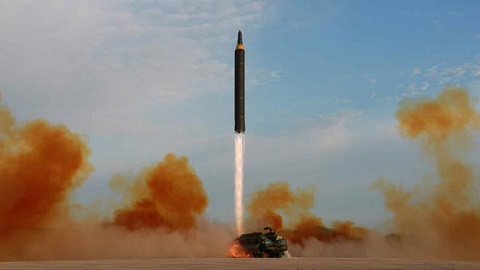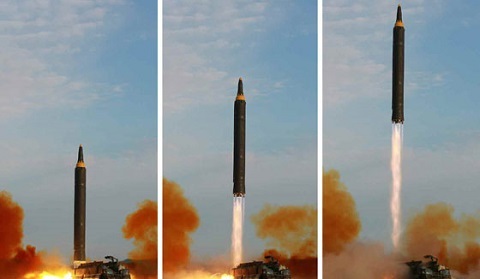The unbelievable truth about North Korea's latest missile launch
On the morning of September 15, North Korea launched an intermediate-range ballistic missile (IRBM) from a site in Sunan, near Pyongyang International Airport, into the Pacific Ocean.
This is the first missile launch that North Korea has conducted since the country tested an H-bomb on September 3, causing strong condemnation from the international community and the United Nations Security Council to impose a new round of sanctions on Pyongyang.
According to the South Korean military's estimate, the missile flew about 3,700km, reaching an altitude of 770km and a flight time of 17 minutes. Japan has issued a warning signal to the people in Hokkaido - where the missile flew over, sounding sirens and turning on warning lights.
Here's some quick analysis of North Korea's latest ballistic missile test, based on initial data:
Launch site and missile trajectory
Notably, on September 15, North Korea chose to launch an IRBM from Sunan - the location where North Korean leader Kim Jong Un oversaw the launch of the Hwasong-12 missile on August 29. The August 29 launch marked the first time a North Korean ballistic missile flew over Japan.
 |
| Photo: Rodong Sinmun |
The choice of Sunan as the IRBM launch site this time shows that North Korea considers this launch site as the main location for missiles, adding to a series of similar sites across the country.
The flight path of the IRBM launched on September 15 was similar to that of the Hwasong-12 missile launched on August 29. However, there was an important difference: this time the missile flew 3,700km, with an altitude of 770km (the Hwasong-12 missile launched by North Korea on August 29 flew 2,700km with an altitude of 550km).
That shows a leap forward for North Korea. The September 15 missile test, which flew over Japan without any interception or reaction from Japan and the US, apart from empty words, will certainly encourage North Korea to conduct further launches in the future.
Pyongyang will continue to use this flight path for long-range missile tests because it fully understands that the US and Japan are certainly unable or unwilling to intercept its missiles. It is likely that the next test will be of the Hwasong-14 intercontinental ballistic missile (ICBM), which will follow the same flight path as the missile North Korea launched on the morning of September 15.
Message to Guam
North Korea’s ballistic missiles now have a range of 3,700 kilometers, surpassing the 2,700 kilometers of the Hwasong-12 missile it launched on August 29. This 3,700-kilometer range has given North Korea a strategic boost, demonstrating that it can strike the US territory of Guam if it so chooses.
US intelligence agencies agree that North Korea has the ability to mount nuclear devices on ballistic missiles.
The only question that remains after North Korea's September 15 missile test is how accurate the missiles were.
While accuracy is not much of an issue for a thermonuclear warhead mounted on a Hwasong-14 intercontinental ballistic missile launched at a US city, it is an issue for attacks on military targets in Guam, such as Andersen Air Force Base.
 |
| Photo: Rodong Sinmun |
In any case, demonstrating that North Korea has missiles capable of reaching Guam is crucial for North Korea, as it would make its nuclear strategy more credible.
Technical objectives
North Korea does not conduct these tests simply as provocations without any reason. While the latest test (September 15) was politically motivated, demonstrating Pyongyang’s displeasure with recent UN Security Council sanctions, it likely also provided North Korea with important technical data (and increased credibility for its nuclear strategy).
However, just like after North Korea tested the Hwasong-12 missile on August 29, there is now a question: How can North Korea observe the final flight phase of the missile they launch?
Because North Korea lacks satellites and coastal radars are limited in their ability to observe them due to the curvature of the Earth, it would probably have to either give up observing them or send ships to where it thinks the missiles will fall.
There is no evidence to date that the country sent a ship to observe the missile’s landing site during the August 29 launch. However, a US government source familiar with North Korea’s ballistic missile tests told The Diplomat that US military intelligence detected a reentry vehicle operating effectively at an altitude of 1km above sea level on August 29.
Experts' comments
"North Korea has made a strategic decision to demonstrate its capabilities as soon as possible. That means they will accelerate in 2017," said Euan Graham, director of the International Security Program at the Lowy Institute in Sydney, Australia. "The missile that North Korea launched on September 15 was the longest-range missile in North Korea's history."
"This is their most successful missile design to date. It marks a new stage in the development of North Korea's IRBMs, demonstrating that these missiles can reach Guam if launched on a conventional ballistic trajectory."
Physicist David Wright of the Union of Concerned Scientists agreed, saying: "North Korea has demonstrated that it has the ability to launch a missile that can reach Guam, although it is unclear how much explosive it can carry" and its accuracy remains questionable.
"North Korea is sending a message: 'We are not afraid of any sanctions, and our warnings are not empty threats,'" said Yang Moo-jin of the University of North Korean Studies in Seoul. North Korea has vowed that the US will face 'pain and loss' if Pyongyang retaliates against UN sanctions.
According to Baotintuc
| RELATED NEWS |
|---|


